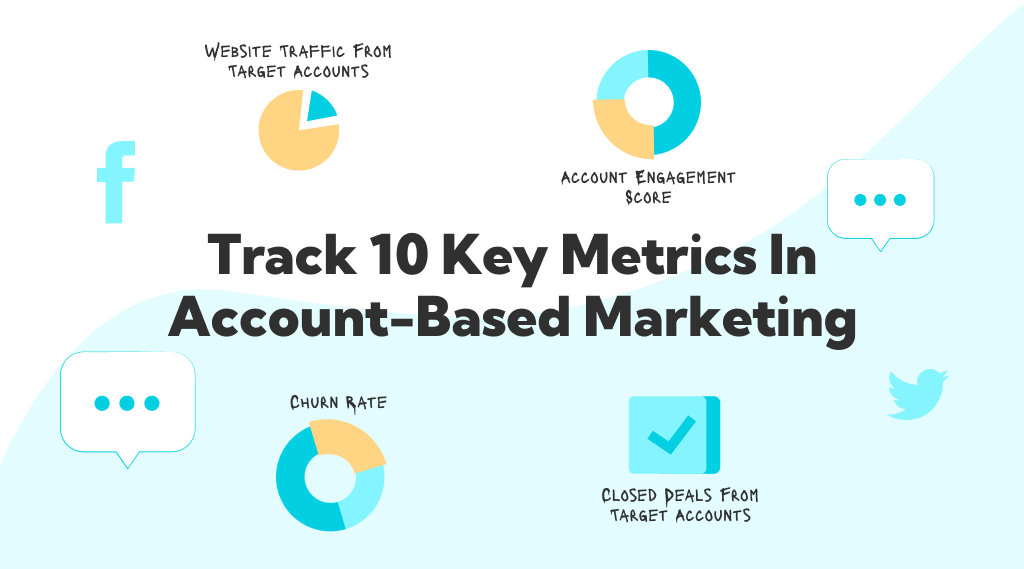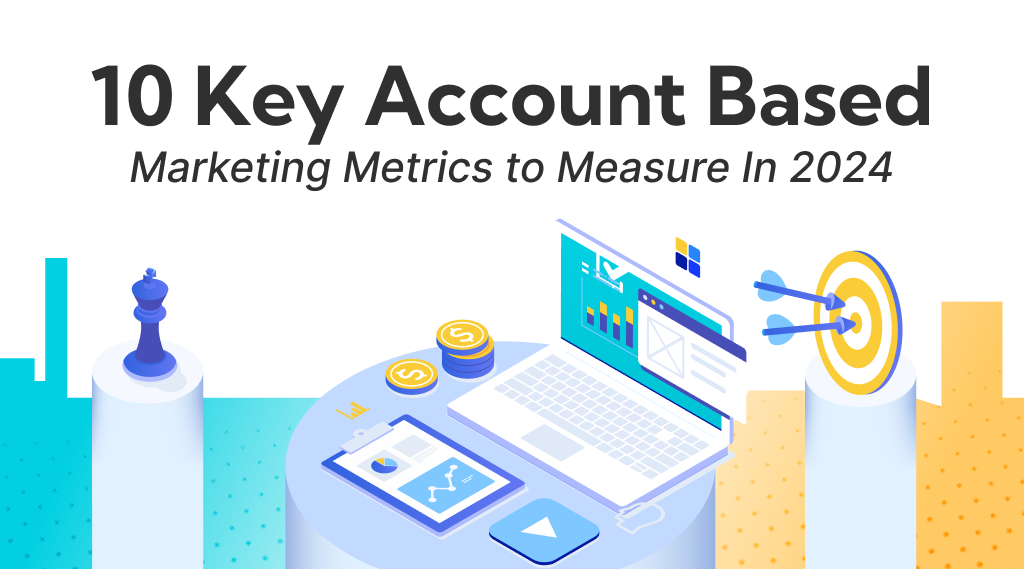Introduction
Account-Based Marketing (ABM) is a strategic approach to marketing that focuses on building relationships and engaging with key accounts. It is a highly targeted approach that can be very effective in generating leads, closing deals, and expanding revenue from existing accounts.
To measure the success of your ABM efforts, it is important to track the right account based marketing metrics. These metrics should be aligned with your specific ABM goals and objectives
What is account based marketing (ABM)?
Account-based marketing (ABM) is a strategic approach to marketing that focuses on building relationships and engaging with key accounts. It is a highly targeted approach that can be very effective in generating leads, closing deals, and expanding revenue from existing accounts.
In ABM, marketers and salespeople work together to identify a set of target accounts that are a good fit for the company’s products or services. They then develop personalized marketing and sales campaigns for each target account.
ABM campaigns can be executed through a variety of channels, including email, social media, direct mail, and advertising. The goal of ABM campaigns is to provide target accounts with relevant and valuable content and experiences that will help them to understand how the company’s products or services can solve their problems and achieve their goals.
ABM can be a very effective way to grow a business, but it is important to note that it is not a quick fix. It takes time and effort to build relationships with key accounts. However, the long-term rewards of ABM can be significant.
Here’s an explanation of ABM with an example:
Imagine you work for a software company that specializes in providing project management solutions for large enterprises. Your typical sales cycle involves lengthy negotiations and high-touch engagements. Instead of mass marketing campaigns targeting any business looking for project management software, you decide to implement an ABM strategy.
1. Identify target accounts:
You collaborate with your sales team to identify a list of high-value accounts that are an ideal fit for your project management software. These accounts could be large corporations in industries such as technology, finance, or healthcare.
2. Research and understand:
Once you’ve identified your target accounts, you conduct thorough research to understand their specific pain points, challenges, and goals related to project management. You gather information about key decision-makers within these organizations.
3. Create personalized content and messaging:
Based on the insights gained from your research, you develop highly personalized content and messaging tailored to address the unique needs of each target account. This could include case studies, whitepapers, and presentations that demonstrate how your software can solve their specific challenges and help them achieve their goals.
4. Engage decision-makers:
Using a combination of targeted advertising, personalized email campaigns, and direct outreach, you engage with decision-makers within the target accounts. Your messaging focuses on demonstrating the value proposition of your software and how it can address their specific pain points.
5. Coordinate sales And marketing efforts:
Throughout the engagement process, you maintain close alignment between your marketing and sales teams. Marketing provides sales with valuable insights and content to facilitate meaningful conversations with prospects, while sales provides feedback to marketing on the effectiveness of the messaging and materials.
6. Measure and optimize:
As you engage with target accounts, you track key metrics such as engagement rates, conversion rates, and deal velocity. You use this data to measure the effectiveness of your ABM efforts and make adjustments as needed to optimize your strategy.
Example:
Let’s say one of your target accounts is a large technology company struggling with project management inefficiencies. You create personalized content highlighting how your software has helped similar technology companies streamline their project workflows, increase productivity, and reduce costs.
You use targeted LinkedIn ads to reach decision-makers within the company, and you also send personalized email campaigns to key contacts. Through these efforts, you secure a meeting with the company’s VP of Operations, where you deliver a tailored presentation demonstrating how your software can address their specific pain points. Eventually, this engagement leads to a successful sale, demonstrating the effectiveness of your ABM strategy.
What are the 10 key account-based marketing metrics you need to track?

Here are the 10 key metrics in account-based marketing (ABM) that you need to track:
1. Website traffic from target accounts:
This metric measures the amount of traffic that your website receives from your target accounts. It is a good indicator of how interested your target accounts are in your products or services.
2. Leads generated from target accounts:
This metric measures the number of leads that you generate from your target accounts. It is a good indicator of the effectiveness of your ABM campaigns in generating qualified leads.
3. Marketing qualified leads (MQLs) from target accounts:
This metric measures the number of MQLs that you generate from your target accounts. MQLs are leads that have been qualified by your marketing team and are considered to be a good fit for your products or services.
4. Sales qualified leads (SQLs) from target accounts:
This metric measures the number of SQLs that you generate from your target accounts. SQLs are leads that have been qualified by your sales team and are considered to be ready to be contacted by a salesperson.
5. Opportunities created from target accounts:
This metric measures the number of opportunities that you create from your target accounts. Opportunities are sales leads that have progressed through the sales funnel and are considered to be close to closing.
6. Closed deals from target accounts:
This metric measures the number of deals that you close from your target accounts. It is the most important ABM metric to track, as it directly impacts your revenue.
7. Account engagement score:
This metric measures the level of engagement that your target accounts have with your marketing and sales activities. It is a good indicator of how interested your target accounts are in your products or services and how likely they are to become customers.
8. Customer lifetime value (CLV):
CLV metric measures the average amount of revenue that you generate from a customer over their lifetime. It is an important ABM metric to track, as it helps you to understand the value of your target accounts and to optimize your ABM campaigns accordingly.
9. Net promoter score (NPS):
This metric measures the loyalty of your customers. It is a good indicator of how satisfied your customers are with your products or services and how likely they are to recommend your company to others.
10. Churn rate:
Churn rate measures the percentage of customers that you lose over a period of time. It is an important ABM metric to track, as it can help you to identify areas where you need to improve your customer experience.
By tracking these key ABM metrics, you can gain valuable insights into the performance of your campaigns and make necessary adjustments to improve results.
Additionally, you may also want to track other metrics that are specific to your business and your ABM goals. For example, if you are focused on expanding revenue from existing accounts, you may want to track the number of new opportunities that you create within your target accounts.
It is important to note that there is no one-size-fits-all approach to ABM metrics. The best metrics to track will vary depending on your specific business goals and objectives. However, the 10 metrics listed above are a good starting point for any ABM program.
What are the best channels for ABM?
The best channels for account-based marketing (ABM) depend on your target accounts and their preferences. However, some of the most common and effective channels for ABM include:
1. Email:
Email is a great way to reach your target accounts directly and deliver personalized messages. You can use email to send target accounts, case studies, blog posts, webinars, and other content that is relevant to their needs and challenges.
2. LinkedIn:
LinkedIn is a great platform for connecting with professionals at your target accounts. You can use LinkedIn to send direct messages, share content, and join relevant groups.
3. Social media:
Social media platforms like Twitter, Facebook, and Instagram can be used to reach your target accounts with personalized messages and content. You can also use social media to run targeted ads.
4. Direct mail:
Direct mail can be used to send target accounts personalized letters, brochures, and other physical materials. Direct mail can be a great way to stand out from the competition and make a lasting impression.
5. Telemarketing:
Telemarketing can be used to connect with target accounts on a personal level. You can use telemarketing to qualify leads, answer questions, and schedule appointments.
You can also use other channels for ABM, such as paid advertising, webinars, and events. The best way to choose the right channels for your ABM campaigns is to consider the preferences of your target accounts.
Conclusion
Account-based marketing (ABM) is a highly targeted and personalized approach to marketing that can help you generate more leads, close more deals, and expand revenue from existing accounts. By focusing on the right accounts and developing personalized messages, you can create a more meaningful connection with your target customers and increase your chances of success.
We also offer a variety of other ABM resources, such as webinars, blog posts, and case studies. And if you’re looking for more personalized help, we offer ABM consulting services to help you develop and implement a custom ABM strategy for your business.
So what are you waiting for? Visit Revvgrowth.com today to learn more about ABM and how it can help you grow your SaaS business.


